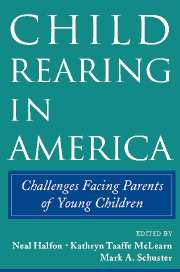Book contents
- Frontmatter
- Contents
- Tables
- Figures
- Contributors
- Acknowledgments
- 1 Introduction and Overview
- PART I CONDITIONS OF FAMILIES WITH YOUNG CHILDREN
- PART II CHILD-REARING PRACTICES
- PART III DELIVERY OF HEALTH SERVICES TO MOTHERS AND CHILDREN
- PART IV FUTURE DIRECTIONS AND POLICY IMPLICATIONS
- 12 New Models of Pediatric Care
- 13 Families with Children Under 3: What We Know and Implications for Results and Policy
- Index
- References
13 - Families with Children Under 3: What We Know and Implications for Results and Policy
Published online by Cambridge University Press: 15 July 2009
- Frontmatter
- Contents
- Tables
- Figures
- Contributors
- Acknowledgments
- 1 Introduction and Overview
- PART I CONDITIONS OF FAMILIES WITH YOUNG CHILDREN
- PART II CHILD-REARING PRACTICES
- PART III DELIVERY OF HEALTH SERVICES TO MOTHERS AND CHILDREN
- PART IV FUTURE DIRECTIONS AND POLICY IMPLICATIONS
- 12 New Models of Pediatric Care
- 13 Families with Children Under 3: What We Know and Implications for Results and Policy
- Index
- References
Summary
This volume offers a rich and detailed picture of the lives of families with very young children. Using data from The Commonwealth Fund Survey of Parents with Young Children as a starting point, each contributor has provided important insights about the context of early child rearing and the challenges young families face, the supports they receive, especially from the health system, and how they are performing the important tasks of rearing young children. Such a broad portrait, based on nationally representative data, has not been attempted before. What emerges is a picture of the complex forces that influence families and their child-rearing behaviors during a period when much is happening and changing in the life of a young child.
In this concluding chapter, we synthesize major themes and consider how the research findings, analysis, and interpretations presented by the contributors could inform public policies targeted at improving the lives of young children and their families. We begin by considering the family, community, and policy context of early childhood in order to frame and interpret the results. We then summarize the major findings and consider their implications for the development of specific and general policies in three distinct areas: the health care system, particularly the provision of pediatric health services; community-level efforts to support families with young children; and wider federal and state policies, including funding for family support and coordination of early childhood programs.
- Type
- Chapter
- Information
- Child Rearing in AmericaChallenges Facing Parents with Young Children, pp. 367 - 412Publisher: Cambridge University PressPrint publication year: 2002
References
- 8
- Cited by



